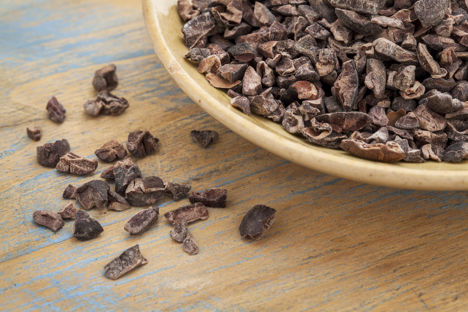
Cacao nibs: the origins, benefits and uses
They're popping up in healthy eating circles, praised on baking blogs and featured on television, but what exactly are cacao nibs are how can they be used in the kitchen at home? We've got all the answers to any questions you've got about this delicious superfood.
Cacao nibs: the origins, benefits and uses
They're popping up in healthy eating circles, praised on baking blogs and featured on television, but what exactly are cacao nibs are how can they be used in the kitchen at home? We've got all the answers to any questions you've got about this delicious superfood.
Cast your eye over the window of any high-end pâtisserie shop, restaurant menu or even supermarket shelf and you’ll probably spot a relatively new ingredient that five years ago would be tough to track down: cacao (or cocoa) nibs. Unlike traditional chocolate, these nibs are simply little shards of roasted cacao bean, which has been allowed to ferment and then dry out. In normal chocolate production, these nibs would then be ground and combined with sugar (and then ground down to a fine powder, melted and tempered) to create chocolate.
Obviously, the lack of added sugar means cacao nibs aren’t anywhere near as sweet as the average chocolate bar. They still taste a little like chocolate, but have a much more bitter, natural flavour. It’s this unique taste, combined with the satisfyingly crunchy texture of nibs that have made them popular today, while the associated health benefits – cacao flavanols, antioxidants and essential nutrients – are the icing on the cake.
Cacao: a history
Cacao trees only grow within twenty degrees of the equator, and the world’s demand for chocolate means they’ve been planted almost everywhere they can be. Now over seventy percent of the world’s cocoa comes from west Africa, but the plant itself is native to South America and was first enjoyed as an alcoholic drink as far back as 1500 BC. In Mesoamerica, cacao was smoked and made into a drink by the elite of society, and was used as currency by the Mayans, Aztecs and Chimimeken.
It wasn’t until the beginning of the sixteenth century that cacao began to make its way outside South America. Once the Spanish had all but wiped out the Aztecs and established a colony, they began exporting cacao beans back home. By the seventeenth century, it was a highly prized luxury and chocolate shops began popping up all over Europe, selling cacao-based beverages. It wasn’t until 1776 that cacao was first processed into cocoa powder, and from 1828 new processes meant it was cheaper to produce and formed into chocolate bars. This meant nearly all cacao nibs were used to make chocolate, and they became more and more difficult to source in their raw state.
Nibs today
Our obsession with chocolate has grown and grown over the past 200 years and worked its way into all aspects of food and drink. With our newfound appreciation for quality ingredients and provenance, it was only a matter of time until we rediscovered cacao in its pure form. Nibs are now used in all sorts of dishes and are particularly popular with home bakers looking to give their creations a new twist. The crunchy texture, bitter taste and unmistakable chocolate flavour make them perfect for sprinkling on top of cakes, or they can be baked into biscuits as a healthier alternative to chocolate chips.
With the current interest in healthy eating, cacao nibs are also popular for the health-conscious who want to avoid processed chocolate. Cacao nibs are full of cacao flavanols (proved to support circulation), antioxidants (which are vital to maintaining healthy cells within the body) and essential nutrients such as iron, magnesium, potassium and calcium. The fact that nibs taste great too means they’re enjoying a real renaissance – so much so that they’re being used in everything from brewing to preserving. Dean Parker at The Manor in Clapham uses then to make a sweet miso; they’re being used to flavour sauces for game birds and almost every chocolate dessert around benefits from the added crunch of cacao nibs. Pick up a pack and give them a try in your next batch of biscuits – you might just discover a whole new way to enjoy chocolate.

